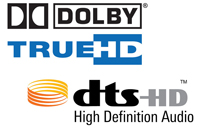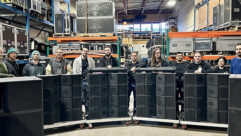

Blu-Ray: It’s Also About the Sound
Sep 21, 2009 10:01 AM,
By Jason Bovberg
There have been a few benefits to jumping first into the now-defunct HD DVD market before making my way into the Blu-ray realm. The first benefit was that, thanks to HD DVD pricing in the midst of its death throes, I could get my feet wet with high-definition before taking an expensive plunge. I purchased my first HD DVD player for a mere $99 and have been finding HD DVDs for less than $5 ever since, and they look just as brilliant as the Blu-ray collection I’m now building. Another, perhaps less obvious benefit of my evolution from DVD to HD DVD to Blu-ray is that, in a way, it has really enhanced my appreciation for the sound quality of today’s Blu-ray releases.
Most of us are drawn to Blu-ray (and HD DVD)—indeed, the very notion of high-definition video discs—because of the promised evolution in image resolution. And boy, do the next-generation DVD formats deliver. Particularly on larger displays, the image improvements are obvious, offering a bright, sharp, detailed, film-like experience that pops from the screen. I admit that after finishing the construction of my home theater, I spent the first couple weeks or so just savoring that image, that perfect image, as it played out richly before me. My upgrade from a 65in. rear-projection setup to a 106in. front-projection image meant that—at the conclusion of my project, when I was sitting down to test the experience—I was almost solely concerned with video. Or at least, my audio concerns were focused merely on how the room dynamics would affect the sound quality of the existing Atlantic Technology loudspeaker system I carried over into the new room.
Related Links

Upgrading from DVD to Blu-ray: The Movie Collector’s Dilemma
If you’re like me, your movie collecting really began in earnest with the introduction of the DVD format…
It was only later that I began to come to a certain audio understanding. On my DVD collection, and even most of the HD DVDs I’d collected, I’d been enjoying the typical “lossy,” compromised Dolby Digital 5.1 and DTS 5.1 tracks common to the DVD format. These were admittedly nice-sounding, fairly dynamic tracks that I’d just become accustomed to over the years. I was a DVD reviewer for many years, and I have fond memories of certain DVD audio tracks blowing me away with the fidelity and envelopment that I perceived at the time. I fondly remember my first viewing of the multichannel Usual Suspects DVD, the way the rich incidental noise in the soundtrack’s background created a three-dimensional soundscape all around me. And later, watching David Fincher’s Seven and listening to hard rain fall around me while Howard Shore’s haunting score the whole room.
It’s interesting how perception can evolve. Remember back to the dawn of DVD, when you first beheld that perfect digital image? Remember how perfect it looked? You might have even wondered whether the image quality could ever be topped. But as we lived with DVD, we began to notice its inherent flaws, which were the direct result of digital compression. We saw image blocking and artifacting. Compression in audio tracks was perhaps less noticeable, betraying itself with a certain flatness, or a degradation at the high end. But we didn’t mind so much, because DVD was such a quantum leap over previous home-video formats.
But why not strive for perfection? As I began experimenting with high definition in HD DVD, I would run across an occasional high-definition audio track. I began to get familiar with terms such as PCM, Dolby TrueHD, and DTS HD. As I marveled over the obvious video improvements that HD DVD brought to the table, I was also experimenting—albeit as almost an afterthought—with high-def audio. And my ears started, tentatively, to perk up.
However, it was only after graduating to Blu-ray that I truly began to savor the benefits that these high-fidelity audio tracks were bringing to the home-theater experience. A new powerhouse Pioneer Elite receiver understood how to properly decode these tracks, and my room exploded with deep, rich sound.
The vast storage capabilities of the Blu-ray Disc provided ample room for some discs’ PCM tracks, which are precise reproductions of the studio master. In my new home theater, this new audio options filled the space with rich, vibrant sound, making my loudspeaker system sound far more capable than I’d though possible. Dolby’s high-def option, Dolby TrueHD, equally filled the theater, enveloping the listeners with subtle, unstrained power. And the more rare DTS HD seemed the most dynamic of all, providing an almost liquid audio presence—all from my relatively modest loudspeaker setup! It was like a revelation.
My point is that, if you’re still on the fence about jumping into the realm of Blu-ray or high definitions in general, remember that the benefits of upgrading won’t fall only in the video arena. Perhaps that’s an obvious point. But don’t underestimate the great evolutionary step that the format brings not only to the eyes but also to the ears.
For a decade, we’ve enjoyed what I consider to be an intermediary step (DVD) between a low-fi (VHS) and high-fi (Blu-ray) home theater experience. We’ve wrestled with the inherent limitations of a developing format, and now we can finally enjoy the fulfillment of that format’s potential—in more ways than one.
And if you’re already enjoying the Blu-ray format, savoring the imagery on your new HDMI-connected 1080p monitor, don’t neglect your ears! Your next investment needs to be a receiver capable of decoding these sumptuous soundtracks, along with a respectable 5.1 or 6.1 loudspeaker arrangement. And then your home theater experience will be complete.
For an excellent explanation of all your audio options on HD DVD and Blu-ray, check out Joshua Zyber’s High-Def FAQ: Blu-ray and HD DVD Audio Explained.










